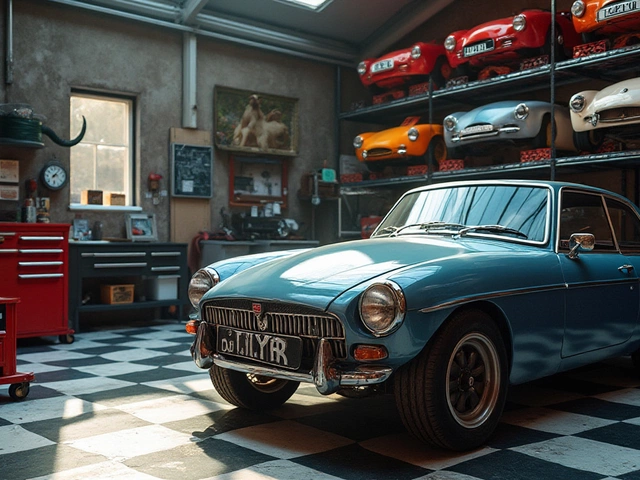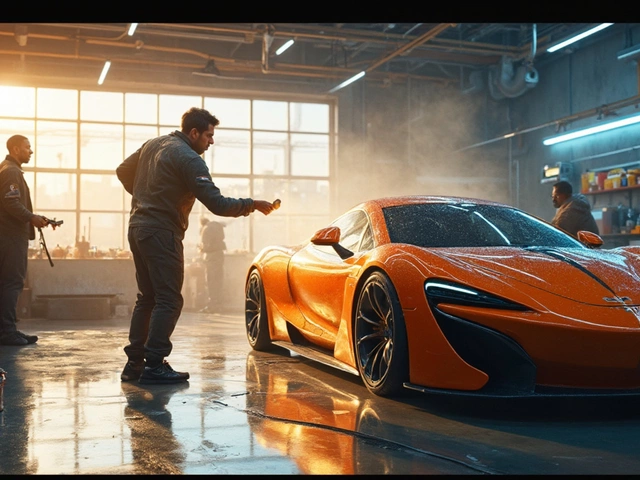When you're driving down the road, every now and then, a car catches your eye. It seems wider, more imposing, and altogether different. You've likely spotted something known as a widebody car. This type of vehicle modification not only amplifies the car's visual presence but also often enhances its handling capabilities.
Widebody cars feature modifications that widen the body beyond the standard factory dimensions. These changes can include broader fenders, extended bumpers, and wider tires that protrude out for an aggressive stance. While some widebody kits are purely aesthetic, others provide real performance improvements by allowing for larger wheel and tire combinations, improving grip and stability.
Understanding what makes a car widebody can help enthusiasts and newcomers alike appreciate the art of vehicle modification. Let’s delve into the specifics of how these conversions are achieved and how you can identify them on the street.
- Defining Widebody Cars
- Features of Widebody Kits
- Benefits of Widebody Conversions
- Spotting the Differences
Defining Widebody Cars
When we talk about widebody cars, we're diving into a world where machinery meets artistry. These vehicles are more than just machines; they're expressions of personality and power, tailored to stand apart on any street or track. The term 'widebody' usually refers to modifications that literally widen the body of the car beyond its original specs. This isn't about subtle tweaks; it's about transforming the very silhouette of the car, projecting dominance and speed even when standing still.
The allure of the widebody lies in the transformation it undergoes from a stock car to something more individualized. At the most basic level, widebody modifications involve extending the width of a vehicle's fenders to accommodate larger wheels and tires. This isn't just an aesthetic indulgence—it's a performance enhancement. With wider tires and a broader stance, a vehicle can better handle the rigors of sharp cornering and rapid acceleration. Grip improves, and with it, the ability to stay planted during spirited driving.
One of the most iconic examples comes from the world of motorsport, where aerodynamics and handling are key. In fact, many road-going car body kits that we see today draw inspiration from racing. The integration of wider fenders combined with aerodynamic aids like splitters and diffusers can markedly alter a vehicle's performance capabilities. According to Andy Blackmore, a renowned car designer, "The shapes and contours of a widebody car are dictated by necessity as much as desire," highlighting how function and form seamlessly blend in these creations.
Not every widebody car you see is built the same way. Manufacturers like Porsche and Ferrari occasionally release factory-built widebody models, where every detail is engineered to enhance performance. However, the art of customization comes alive in the aftermarket scene, where enthusiasts craft their unique interpretations. There’s a precise balance between aesthetics and engineering in these builds. The widened arches, bespoke bumpers, and side skirts work together not just to catch the eye, but to improve physical performance.
Widebody History and Evolution
The journey of the widebody style isn't something that happened overnight. Its roots are intertwined with the evolution of motor racing and the constant pursuit of speed. Initially, modifications like these were exclusive to the racetrack, developed to accommodate the wider tires needed for increased grip. As automotive technology advanced, the benefits of these wide stances became desirable for road cars aiming to offer similar thrills. From early racing modifications in the 70s to today's advanced composite materials, the technology behind widebody kits has evolved immensely. This historical context gives a deeper appreciation for what these modifications achieve beyond their stunning looks.
For those seeing a widebody setup for the first time, the immediate effect is jaw-dropping. But beneath the surface, there's a fascinating blend of engineering benefits. You'll find them on cars designed to tear up race tracks or simply cruise city streets while turning heads at every stoplight. It's this duality—between beauty and brawn—that defines the essence of widebody cars, making them a beloved staple in the car culture landscape.

Features of Widebody Kits
The transformation of a standard vehicle into a widebody car is a process that elevates its visual appeal and capability. Among the most noticeable changes are the widened fenders. These fenders are designed to accommodate broader tires, essential for achieving that beefy look and improved road grip. Flaring out the wheel arches not only allows for a larger contact patch but also helps distribute weight more evenly during cornering, offering a tangible advantage in handling dynamics.
Another key component of these kits is the custom bumpers and side skirts. These are often specifically engineered to enhance aerodynamics, reducing drag while increasing downforce. The bumpers usually feature vents to optimize airflow around the brakes, which is crucial for maintaining performance in high-stress situations. Side skirts bridge the gap between the wider wheels and the vehicle's body, giving the car a seamless, aggressive look.
Notably, widebody kits add a substantial amount of material to the vehicle, which can introduce new challenges regarding weight and structural integrity. However, modern kits frequently employ lightweight materials like fiberglass or carbon fiber, balancing the need for durability without compromising speed or efficiency. Some enthusiasts quote, "A widebody kit isn't just about the look; it's about pushing limits," emphasizing that for many, these features are about more than aesthetics. They define the character and capability of the vehicle.
Lighting elements should not be overlooked either. A complete widebody conversion might also involve altering the headlight and taillight assemblies to match the new dimensions. This meticulous attention to detail ensures that all elements of the car are harmonious in their exaggerated proportions. Occasionally, these kits come with a name or brand attachment, like Liberty Walk or Rocket Bunny, known for bold, distinctive designs that are anything but subtle.
Statistics from the automotive aftermarket suggest that more than 70% of widebody enthusiasts opt for kits that allow for personalized customization. This includes choosing finishes, paint colors, and additional accessories that make each widebody unique. Here's an interesting statistic: a survey revealed that cars equipped with a widebody modification experience a 15% increase in lateral grip due to the ability to mount wider tires.
The allure of the car body kit lies not just in the individual components but in the cohesiveness achieved when they come together. These features work in concert to redefine the vehicle's silhouette, adding not only breadth but also character, making a statement of power and presence on the road.

Benefits of Widebody Conversions
Transforming a car into a widebody car is a decision that often goes beyond sheer aesthetics. For many, the widebody conversion is about enhancing the vehicle’s performance and functionality. A significant benefit lies in the improved handling and stability. By widening the track, a car can have better grip, especially during high-speed cornering. This wider stance lowers the car's center of gravity, thus providing a more grounded driving experience. Imagine driving through curves with increased confidence, feeling the road as the car hugs tightly, not letting go. Enthusiasts often tout these modifications as bringing an exhilarating sense of control that was previously untapped.
Another area where widebody conversions shine is in offering more room for customization. A wider body means more space for larger wheels and tires, which can significantly improve traction and braking performance. Larger wheels are not just for show; they support more efficient heat dissipation and better surface contact, which can make a world of difference during spirited driving or on track days. Additionally, this allows for upgraded brake systems, which can now accommodate larger calipers and rotors, ensuring stopping power is as strong as the engines pushing these beasts forward.
Often, widebody kits also include aerodynamic enhancements. These enhancements, such as splitters, diffusers, and larger rear wings, are not just cosmetic. They serve a functional purpose by managing airflow over and around the car, minimizing drag, and maximizing downforce. This translates to higher speeds with more stability, an aspect that further emphasizes the driving experience. A well-designed kit can provide a balanced design that maintains the harmony between form and function. According to renowned car designer Ken Block,
"Widebody conversions can significantly transform the dynamics of a car, turning a standard ride into something extraordinary, both visually and functionally."His insights reveal the dual appeal of increased performance and aesthetic enhancement.
There are economic benefits as well. While initial costs might seem steep, the returns in terms of enhanced car capabilities and longevity can be appealing. The increased performance can reduce certain wear on specific parts due to the superior handling, thereby potentially lowering long-term maintenance costs. In some markets, a well-done widebody conversion might even enhance resale value, as enthusiasts are always on the lookout for unique, tastefully modified cars that stand out from the factory-standard crowd.
Choosing a widebody conversion is as much about personal expression as it is about the functional benefits. When one considers all the tangible benefits, from enhanced handling to increased customization options, it’s easy to see why these conversions are beloved by so many automotive enthusiasts. Whether it’s for the racetrack or simply to command more presence on the streets, the widebody transformation holds manifold attractions that cater to both the heart and the mind of a car lover.

Spotting the Differences
Recognizing a widebody car on the open road can be both an art and a science. These cars stand out due to their unique design choices that set them apart from standard models. One of the most distinctive features is the wider wheel arches, which often house larger tires. These wheel arches are not just for show; they accommodate broader tires that enhance the car's grip on the road. This is an essential characteristic for high-performance vehicles aiming to improve their stability at high speeds.
As you look beyond the arches, you will notice custom bumpers and side skirts that align seamlessly to create a smooth, continuous shape. These additions not only improve the car's aerodynamics but also contribute to its aggressive look. When you see a car with such modifications, it's likely tailored for better airflow and a sportier performance. It's this marriage of functionality and form that captivates automotive enthusiasts everywhere.
To truly differentiate, consider the modifications made to the car's frame and body panels. A widebody conversion often requires significant alterations to the car's original structure. This involves replacing panel parts with custom-made components. These transformations can either come from aftermarket kits or are designed by manufacturers as limited-edition runs. For instance, the Porsche 911 Turbo has been known for its factory-fitted widebody design, which increases both its aesthetic appeal and its performance metrics.
One reliable way to spot a widebody conversion is to check the wheels' alignment with the fenders. If the tires extend further out than usual, creating a more flushed appearance, it's likely a widebody. This alignment helps enhance tire traction by providing a broader contact patch, which is why such modifications are popular among racing enthusiasts. Wider tires mean better grip and improved cornering capabilities, allowing drivers to push their limits on the track or street.
"Widening a car is not only about aesthetics. It translates into better handling and stability," says Chris Harris, a renowned motor journalist for Top Gear. His insights emphasize the synergy between visual modifications and driving dynamics, an essential aspect when considering modifications.
The difference may also lie in the subtle details, such as the integration of the body panels. Are they seamlessly merged with the existing body, or do they seem like add-ons? Factory widebodies often feature smoother transitions compared to some aftermarket kits, which are sometimes installed with visible bolts or rivets. It adds a rugged charm but can indicate a different approach to widebody design.
Sometimes, telling the differences might come down to a car’s badges or subtle aesthetics provided by the makers or aftermarket kits. In recent years, companies like Liberty Walk and Rocket Bunny have become synonymous with car body kits, creating custom widebody designs that emphasize both performance and style. Cars equipped with these specific kits can often be recognized by their aggressive styling and branded emblems, making them distinct even to the untrained eye.






